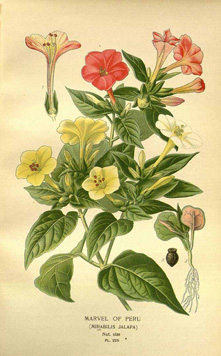Night-Owl Four O’Clocks
By Audrey Stallsmith

Wake up from thy sunset bower
Spread thy leaves, my pretty flower!
Spread thy leaves, unclose thine eyes
For the silver moon doth rise,
And the golden stars are coming,
And the beetle’s at his humming,
And the moth is from his bed
And the cricket from his shed. . .
"The Spanish Maiden’s Song to the Marvel of Peru"--Anonymous
I have a hardy wild four o’clock plant, Mirabilis longiflora, which pops up late every summer. Of course, that usually occurs after I have forgotten it's there and planted something else over it.
This year, I’d purchased a pot of miniature roses after they had been marked down and set them as a kind of mini-hedge at the front of the flower bed. The four o-clock emerged in their fore and, as a result, those formerly flourishing roses have turned leggy from trying to peer over it.
I can’t stay mad at my “sweet-scented Marvel of Peru” for long, however, as it has night-blooming, magenta-centered white flowers about 1 inch across swaying at the end of long white tubes, which give it an ethereally magical look. It is actually native to the southeastern U. S. and some sources mistakenly record it as only being perennial to zone 7. Having had the plant for years, I can testify that it is hardy to zone 5 at least.
The more common Marvel of Peru, Mirablis jalapa, probably is only hardy to zone 7 and can become a nuisance in the south due to its prolific self-seeding. In the north, it is grown as an annual, though you can dig and store its tubers over the winter as you would a dahlia's.
I recall four o’clocks being favorites with my late aunts, the flowers having been around for a long time. Originally cultivated by the Aztecs in Mexico and sent to Spain in the 1500s, they made it to England shortly thereafter. Thomas Jefferson grew Mirabilis jalapa in his garden in 1767 and called it “very clever.” So clever, in fact, that he later grew my plant, Mirabilis longiflora, as well.
Mirabilis means “wonderful” and jalapa is actually a misspelling of a Mexican town called Xalapa. Also known as beauty of the night or clavilla, Mirabilis jalapa sports 2-inch long trumpet-shaped flowers—generally in white, pink, yellow, red, or combinations of those hues. Like a nightclub singer, it wakes in late afternoon--explaining the nickname four o'clock--performs all night, and stays up through breakfast before retiring for the day.
Perhaps its seeming bashfulness about blooming is why the plant stands for “timidity” in the Language of Flowers. However, its blooms do open earlier on cloudy days.
They have a gardenia-like scent, but are much easier to cultivate than gardenias, with the plants sometimes reaching 4 feet in height. In the South, a single tuber eventually may grow to 40 pounds. Although four o’clocks can bloom from mid-spring to mid-fall in those warmer climates, they usually perform from mid-summer to frost here.
Having been so impressed with Mirabilis longiflora, I hope to acquire seeds of another wild four o’clock, Mirabilis multiflora, as well. It too is supposed to be hardier than the garden variety and multiflora promisingly means “many-flowered.”
Most four o'clocks are considered poisonous except Mirabilis expansa, grown in South America to produce a root vegetable called mauka. And even it must be dried in the sun to make it edible. Otherwise, it will burn the mouth.
Just out of curiosity, I checked at four o'clock today to see whether my Mirabilis longiflora flowers were open yet. They weren't.
According to the Burpee web site "The bloom time of four o'clocks (Mirabilis jalapa) is said to correspond to changes in light and temperature, so they open in the cool of the evening, usually between about four and eight PM, or a bit earlier on cloudy afternoons."
So "four o'clocks" might not be the most accurate name for them. However, it does beat "late afternoon or early evening-ish!"
Mirabilis jalapa image is from Favorite Flowers of Garden and Greenhouse by D. G. J. M. Bois, courtesy of plantillustrations.org.








